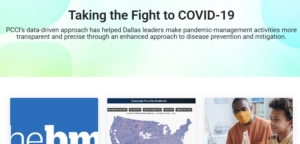
Disparities Next Door: PCCI’s Community Vulnerability Compass spotlights areas of increased vulnerability across Dallas County
Dallas, Texas (Sept. 19, 2024) – Researchers at Parkland Center for Clinical Innovation (PCCI) have highlighted areas of increased vulnerability within Dallas County after conducting an analysis using PCCI’s Community Vulnerability Compass (CVC). The findings include a number of pockets of highly vulnerable areas within many low vulnerability ZIP Codes.
PCCI’s CVC analyzes, at the ZIP Code, census tract, and block-group level, where a community’s most vulnerable residents live and the root cause factors limiting these residents’ ability to thrive. The CVC analyzes 26 clinical and socio-economic indicators that reveal the health, resiliency, and economic vibrancy of neighborhoods. CVC’s analyses provide true, holistic pictures of who needs the most assistance and where to find them, enabling proactive support of those in need.
It is well-documented that many ZIP Codes in the south and southeast areas of Dallas County (see image 1) are home to long-standing socio-economically disadvantaged populations and have the highest vulnerability rating. However, PCCI’s analysis underscores what Parkland and other officials have long stated: that in addition to the south and southeast regions, there are other ZIP Codes in Dallas County with low vulnerability but are home to highly vulnerable block groups. Specifically, these include 18 Dallas County ZIP Codes with an overall very low or low vulnerability rating that contain within them 48 block groups with high or very high vulnerability ratings. The 18 ZIP Codes have a total population of 590,971, with 72,954 (12.3%) of their residents living in these very high vulnerability blocks groups.
“In some cases, we find that a very high area of vulnerability is across the street from a very low area of vulnerability.“
Steve Miff, phd, President and CEO of PCCI
The “very high” designation indicates that these neighborhoods are in the top 20% of vulnerability when compared to the rest of Dallas County. CVC vulnerability groupings are localized to the Dallas County geography and broken into quintiles and clustered into very low, low, moderate, high and very high areas.
“For good reason we focus a lot of our efforts on supporting the underserved communities in south and southeast Dallas County, but CVC empowers us with refined geographic precision to examine our broader community and uncover data that provides a high-resolution understanding of social vulnerability factors within other micro-geographies in our community,” said Steve Miff, PhD, President and CEO of PCCI. “In this examination, CVC highlights areas of deprivation that may be masked by gentrification and/or historical surrounding prosperity. In some cases, we find that a very high area of vulnerability is across the street from a very low area of vulnerability.”
For example, ZIP Code 75206, located in the Greenland Hills area that runs along Highway 75 and is bordered by Highway 12 and Skillman Avenue, is rated very low vulnerability by the CVC, but includes four block groups that are rated by the CVC as high and very high vulnerability. In this ZIP Code, which has a total population of 38,209, there are 2,661 (7%) who experience high or the very highest levels of vulnerability as measured by the CVC.
One ZIP Code of note, 75254, located north of the Galleria between Dallas North Tollway and Coit Road, has an overall low vulnerability rating, but includes 8 high or very high vulnerability blocks. Of this area’s total population of 24,047, 12,522 (52.1%) residents experience high or very high vulnerability. (see Image 2)
Additionally, ZIP Code 75230, which is considered to be an economically advantaged area in North Dallas between Walnut Hill and Interstate 635, includes a very high vulnerability block group.
“The lesson is that we need to look beyond our expectations and understand that disparities and vulnerability are all around us no matter how prosperous a given area may appear,” Miff said. “We hope this will bring an additional level of high-resolution, hyper-localized understanding of social vulnerability factors and empower leaders across all communities with relevant information to improve and sustain the lives of all Dallas County residents. North Texas has outstanding public health leaders who are doing a great job supporting vulnerable populations throughout the county and we hope this helps them as well as policymakers, community-based organizations and others who are vested in helping mitigate disparity.”
IMAGE 1


IMAGE 2
About PCCI
The Parkland Center for Clinical Innovation (PCCI) is a not-for-profit, mission-driven organization with industry-leading expertise in the responsible application of artificial intelligence, machine learning and NMDOH data modeling to address the needs of vulnerable populations. PCCI started as a department within Parkland Health and was spun out as an independent organization in 2012. PCCI strives to leapfrog the status quo by harnessing the transformative potential of data. Our unique capabilities allow us to provide innovative, actionable solutions that more effectively identify needs, prioritize services, empower providers, and engage patients.
###






